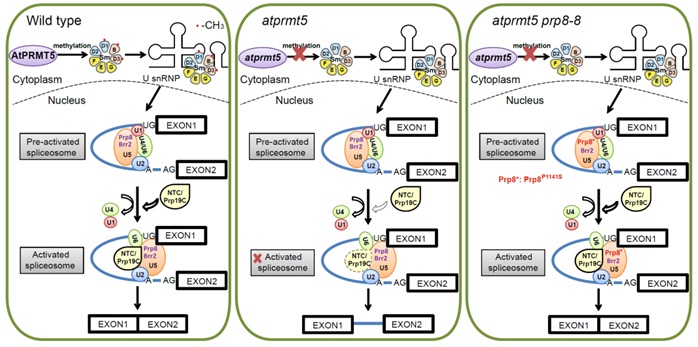Post-translational modification is the key step for regulating the biological funcations of proteins. As an evolutionarily conserved post-translational modification, protein arginine methylation is involved in a multitude of biological processes in eukaryotes. Protein arginine methylation is catalyzed by protein arginine methyltransferases (PRMTs). Loss-of-function of PRMTs not only leads to developmental defects in mammals, but also results in genetic diseases and cancers in human beings. AtPRMT5 is an essential protein arginine methyltransferase in Arabidopsis, which mediates the symmetric arginine dimethylation of histones and non-histone proteins. Loss-of-function of AtPRMT5 leads to multiple defects in plant development and pre-mRNA splicing of diverse genes as well. However, the underlying molecular mechanism remains largely unknown.
On the basis of previous study, researchers from Dr. CAO Xiaofeng’s group in the Institute of Genetics and Developmental Biology, Chinese Academy of Sciences, elucidated the key molecular mechanism for the role of AtPRMT5 in pre-mRNA splicing. From a genetic screen, they identified two suppressors of atprmt5 mutants, encoded by a highly conserved core component of the U5 small nuclear ribonucleoprotein (snRNP), Pre-mRNA Processing factor 8 (Prp8). These two suppressors showed suppression of the developmental and splicing alterations of atprmt5 mutants. Proteomic analysis showed that the NineTeen complex failed to be assembled into the U5 snRNP to form an activated spliceosome, which was restored in the suppressors. Furthermore, they found that the symmetric arginine dimethylation of Sm proteins promotes recruitment of the NineTeen complex and initiation of spliceosome activation, suggesting the key roles of symmetric arginine dimethylation in spliceosome assembly and activation.
This study elucidates a key molecular mechanism for arginine methylation in pre-mRNA splicing and in diverse developmental processes. It is an important advance in understanding spliceosome assembly. It provides not only the guiding significance for the molecular mechanism of protein arginine methylation in plant development, but also the post-transcriptional evidence and clues for human genetic diseases and cancer research.
This work entitled “Recruitment of the NineTeen Complex to the activated spliceosome requires AtPRMT5” has been published online in
PNAS (doi:
10.1073/pnas. 1522458113).
This research was supported by the National Natural Science Foundation of China, the National Basic Research Program of China, and the State Key Laboratory of Plant Genomics.
Model for the role of AtPRMT5 in Prp19C/NTC complex recruitment to the spliceosome during pre-mRNA splicing (Image by IGDB)
AUTHOR CONTACT:
Dr. CAO Xiaofeng
 Model for the role of AtPRMT5 in Prp19C/NTC complex recruitment to the spliceosome during pre-mRNA splicing (Image by IGDB)AUTHOR CONTACT:Dr. CAO XiaofengEmail: xfcao@genetics.ac.cn
Model for the role of AtPRMT5 in Prp19C/NTC complex recruitment to the spliceosome during pre-mRNA splicing (Image by IGDB)AUTHOR CONTACT:Dr. CAO XiaofengEmail: xfcao@genetics.ac.cn CAS
CAS
 中文
中文




.png)
